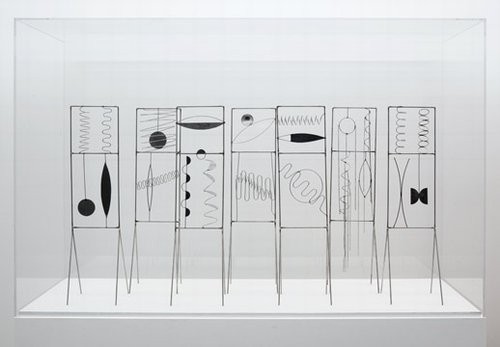Fausto Melotti
09 May - 30 Jul 2010

Fausto Melotti
"I magnifici sette", 1973
Stainless steel; 7 elements, 5 x 5 inches (48.3 x 12.7 x 12.7 cm) each / Overall installed, 19 x 36 x 11 inches (48.2 x 91.4 x 27.9 cm)
"I magnifici sette", 1973
Stainless steel; 7 elements, 5 x 5 inches (48.3 x 12.7 x 12.7 cm) each / Overall installed, 19 x 36 x 11 inches (48.2 x 91.4 x 27.9 cm)
FAUSTO MELOTTI
"I magnifici sette"
May 9 - July 30, 2010
530 West 21st Street, New York
Gladstone Gallery is pleased to announce I magnfici sette by Italian artist Fausto Melotti. A quiet presence throughout the twentieth century, Melotti began exhibiting his work in the 1930s after studying both music and science. Primarily known for sculpture, his initial ceramic Teatrini—poetic dioramas in which lyrical figuration populates miniature theaters—gave way in the 1950s to abstract works composed of elegantly composed brass, wire, and other metals. His background informed his new formal language in which the plastic manifestation of material and form found a corollary in the almost mathematical elegance of both the rhythms and visual structures of music and musical notation. As Melotti said, “Art is an angelic, geometric feeling. It addresses the intellect, not the senses.” In his works, poetic structures of feeling find a medium in response to self-contained abstract forms regardless of haptic modeling, much in the way music conveys meaning through an immaterial sonic construction.
This exhibition will present one monumental work I magnifici sette (The magnificent seven), 1973, a brass and stainless steel sculpture in which seven abstract forms recall the seven disciplines classically defined as the liberal arts—the fields of study that the ancient Greeks thought allowed for a rational understanding of the world. In Melotti’s depiction, seven window-like forms contain rhythmic patterns of geometries bound less by platonic ideals than by a more lyrical contemplation of composition, balance, and order. Recalling non-western forms of musical notation, this sculpture’s quasi-linguistic ordering provokes both contemplation and a necessary respect for the universal presence of the unexpected and uncertain. Of this poetic sensibility of uncertainty Melotti said in his 1963 aphorism: “It is not for us to know, though a genius might, whether the thousand effervescent thoughts, so much in contrast today, like never before, are beginning to agree like the voices in a choir, to finally emerge together in a single voice or whether it shall all collapse in a dark torrent.... We would be content if it were the wind of the Elysian fields, shaking and rattling the empty and sensitive pipes.”
Born in Rovereto, Italy, to a musical family, Fausto Melotti (1901-1986) began studying music, mathematics and physics before enrolling at the prestigious Accademia di Belle Arti di Brera in Milan where he befriended fellow artist Lucio Fontana. His first exhibition was at the Galleria del Milione in Milan in 1935. The Museum am Ostwall Dortmund held the first retrospective of his work in 1971. He exhibited in both Italy and abroad up until his death. The1986 Venice Biennale opened with a major exhibition of Melotti’s work, earning him a posthumous Leone d’Oro.
"I magnifici sette"
May 9 - July 30, 2010
530 West 21st Street, New York
Gladstone Gallery is pleased to announce I magnfici sette by Italian artist Fausto Melotti. A quiet presence throughout the twentieth century, Melotti began exhibiting his work in the 1930s after studying both music and science. Primarily known for sculpture, his initial ceramic Teatrini—poetic dioramas in which lyrical figuration populates miniature theaters—gave way in the 1950s to abstract works composed of elegantly composed brass, wire, and other metals. His background informed his new formal language in which the plastic manifestation of material and form found a corollary in the almost mathematical elegance of both the rhythms and visual structures of music and musical notation. As Melotti said, “Art is an angelic, geometric feeling. It addresses the intellect, not the senses.” In his works, poetic structures of feeling find a medium in response to self-contained abstract forms regardless of haptic modeling, much in the way music conveys meaning through an immaterial sonic construction.
This exhibition will present one monumental work I magnifici sette (The magnificent seven), 1973, a brass and stainless steel sculpture in which seven abstract forms recall the seven disciplines classically defined as the liberal arts—the fields of study that the ancient Greeks thought allowed for a rational understanding of the world. In Melotti’s depiction, seven window-like forms contain rhythmic patterns of geometries bound less by platonic ideals than by a more lyrical contemplation of composition, balance, and order. Recalling non-western forms of musical notation, this sculpture’s quasi-linguistic ordering provokes both contemplation and a necessary respect for the universal presence of the unexpected and uncertain. Of this poetic sensibility of uncertainty Melotti said in his 1963 aphorism: “It is not for us to know, though a genius might, whether the thousand effervescent thoughts, so much in contrast today, like never before, are beginning to agree like the voices in a choir, to finally emerge together in a single voice or whether it shall all collapse in a dark torrent.... We would be content if it were the wind of the Elysian fields, shaking and rattling the empty and sensitive pipes.”
Born in Rovereto, Italy, to a musical family, Fausto Melotti (1901-1986) began studying music, mathematics and physics before enrolling at the prestigious Accademia di Belle Arti di Brera in Milan where he befriended fellow artist Lucio Fontana. His first exhibition was at the Galleria del Milione in Milan in 1935. The Museum am Ostwall Dortmund held the first retrospective of his work in 1971. He exhibited in both Italy and abroad up until his death. The1986 Venice Biennale opened with a major exhibition of Melotti’s work, earning him a posthumous Leone d’Oro.
